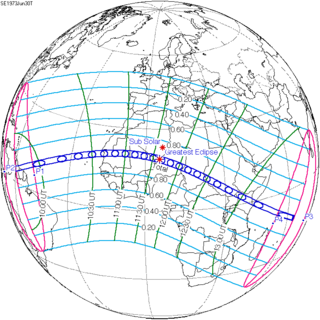Solar eclipse of June 30, 1973
| Solar eclipse of June 30, 1973 | |
|---|---|
| Type of eclipse | |
| Nature | Total |
| Gamma | -0.0785 |
| Magnitude | 1.0792 |
| Maximum eclipse | |
| Duration | 424 sec (7 m 4 s) |
| Coordinates | 18°48′N 5°36′E / 18.8°N 5.6°E |
| Max. width of band | 256 km (159 mi) |
| Times (UTC) | |
| Greatest eclipse | 11:38:41 |
| References | |
| Saros | 136 (35 of 71) |
| Catalog # (SE5000) | 9450 |
A total solar eclipse occurred on June 30, 1973. A solar eclipse occurs when the Moon passes between Earth and the Sun, thereby totally or partly obscuring the image of the Sun for a viewer on Earth. A total solar eclipse occurs when the Moon's apparent diameter is larger than the Sun's, blocking all direct sunlight, turning day into darkness. Totality occurs in a narrow path across Earth's surface, with the partial solar eclipse visible over a surrounding region thousands of kilometres wide.
With a maximum eclipse of 7 minutes and 4 seconds, this was the last total solar eclipse that exceeds 7 minutes in this series. There will not be a longer total solar eclipse until June 25, 2150.
This eclipse was observed by a group of scientists from the Los Alamos National Laboratory using two airplanes to extend the apparent time of totality by flying along the eclipse path in the same direction as the Moon's shadow as it passed over Africa. One of the planes was a prototype of what was later to become the Concorde, which has a top speed of almost 1,300 miles per hour (2,100 km/h)(Mach 2). This enabled scientists from Los Alamos, the Paris Observatory, the Kitt Peak National Observatory, Queen Mary University of London, the University of Aberdeen and CNRS to extend totality to more than 74 minutes; nearly 10 times longer than is possible when viewing a total solar eclipse from a stationary location. The data gathered resulted in three papers published in Nature and a book.
The eclipse was also observed by a charter flight from Mount San Antonio College in Southern California. The DC-8 with 150 passengers intercepted the eclipse at 35,000 feet (11,000 m) just off the east coast of Africa and tracked the eclipse for three minutes. The passengers rotated seats every 20 seconds so that each passenger had three 20 second opportunities at the window to observe and take pictures. A separate observation opportunity was provided on a specialized commercial cruise by the S.S. Canberra, which traveled from New York City to the Canary Islands and Dakar, Senegal, observing close to 8 minutes of totality out in the Atlantic between those two stops in Africa. That cruise's passengers included notables in the scientific community such as Neil Armstrong and Isaac Asimov.
...
Wikipedia

